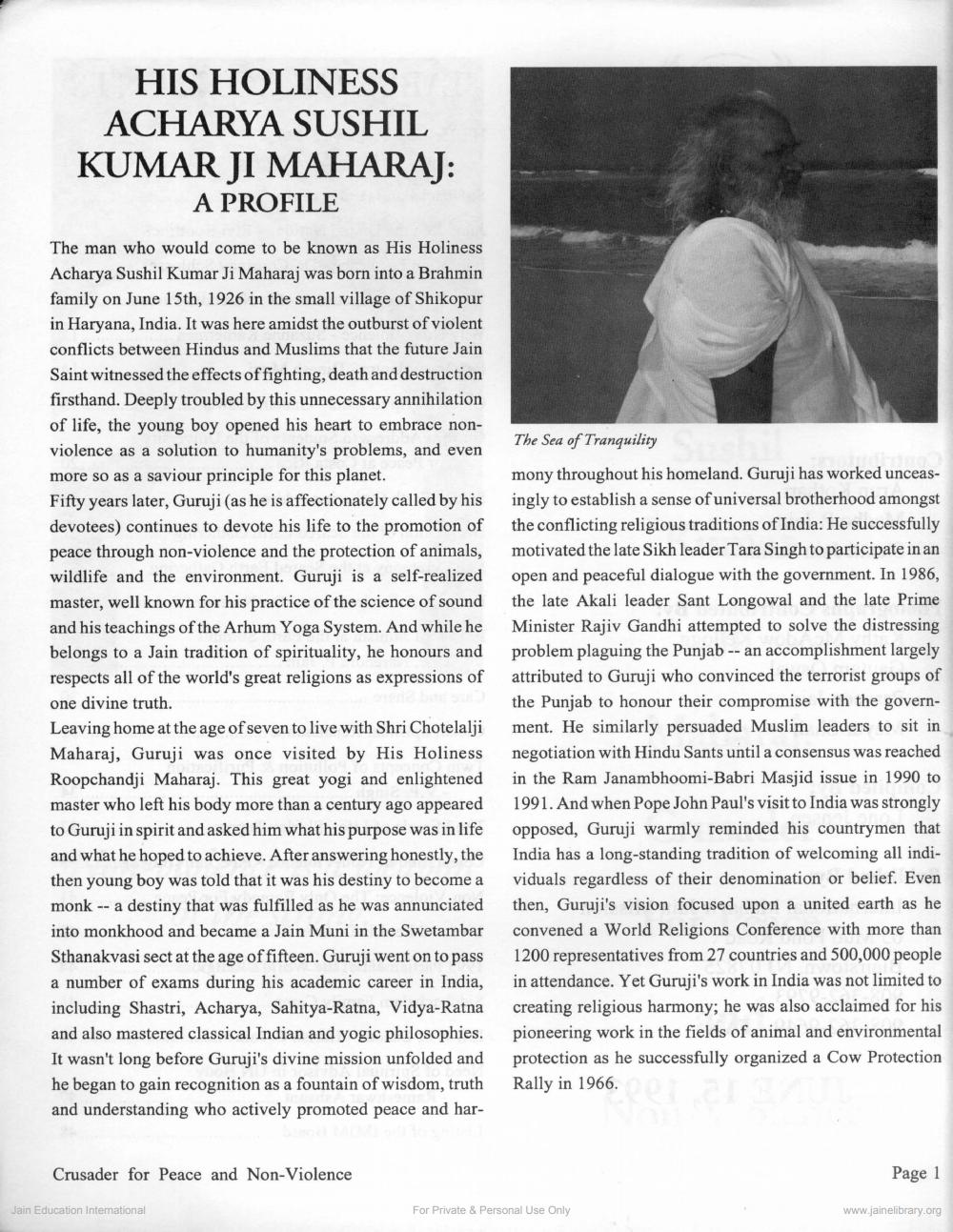________________
HIS HOLINESS ACHARYA SUSHIL KUMAR JI MAHARAJ:
A PROFILE
The man who would come to be known as His Holiness Acharya Sushil Kumar Ji Maharaj was born into a Brahmin family on June 15th, 1926 in the small village of Shikopur in Haryana, India. It was here amidst the outburst of violent conflicts between Hindus and Muslims that the future Jain Saint witnessed the effects of fighting, death and destruction firsthand. Deeply troubled by this unnecessary annihilation of life, the young boy opened his heart to embrace nonviolence as a solution to humanity's problems, and even more so as a saviour principle for this planet. Fifty years later, Guruji (as he is affectionately called by his devotees) continues to devote his life to the promotion of peace through non-violence and the protection of animals, wildlife and the environment. Guruji is a self-realized master, well known for his practice of the science of sound and his teachings of the Arhum Yoga System. And while he belongs to a Jain tradition of spirituality, he honours and respects all of the world's great religions as expressions of one divine truth. Leaving home at the age of seven to live with Shri Chotelalji Maharaj, Guruji was once visited by His Holiness Roopchandji Maharaj. This great yogi and enlightened master who left his body more than a century ago appeared to Guruji in spirit and asked him what his purpose was in life and what he hoped to achieve. After answering honestly, the then young boy was told that it was his destiny to become a monk -- a destiny that was fulfilled as he was annunciated into monkhood and became a Jain Muni in the Swetambar Sthanakvasi sect at the age of fifteen. Guruji went on to pass a number of exams during his academic career in India, including Shastri, Acharya, Sahitya-Ratna, Vidya-Ratna and also mastered classical Indian and yogic philosophies. It wasn't long before Guruji's divine mission unfolded and he began to gain recognition as a fountain of wisdom, truth and understanding who actively promoted peace and har
The Sea of Tranquility mony throughout his homeland. Guruji has worked unceasingly to establish a sense of universal brotherhood amongst the conflicting religious traditions of India: He successfully motivated the late Sikh leader Tara Singh to participate in an open and peaceful dialogue with the government. In 1986, the late Akali leader Sant Longowal and the late Prime Minister Rajiv Gandhi attempted to solve the distressing problem plaguing the Punjab -- an accomplishment largely attributed to Guruji who convinced the terrorist groups of the Punjab to honour their compromise with the government. He similarly persuaded Muslim leaders to sit in negotiation with Hindu Sants until a consensus was reached in the Ram Janambhoomi-Babri Masjid issue in 1990 to 1991. And when Pope John Paul's visit to India was strongly opposed, Guruji warmly reminded his countrymen that India has a long-standing tradition of welcoming all individuals regardless of their denomination or belief. Even then, Guruji's vision focused upon a united earth as he convened a World Religions Conference with more than 1200 representatives from 27 countries and 500,000 people in attendance. Yet Guruji's work in India was not limited to creating religious harmony; he was also acclaimed for his pioneering work in the fields of animal and environmental protection as he successfully organized a Cow Protection Rally in 1966,
Crusader for Peace and Non-Violence
Page 1
Jain Education International
For Private & Personal Use Only
www.jainelibrary.org




